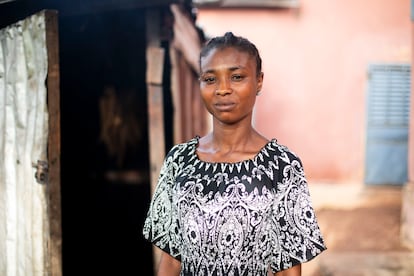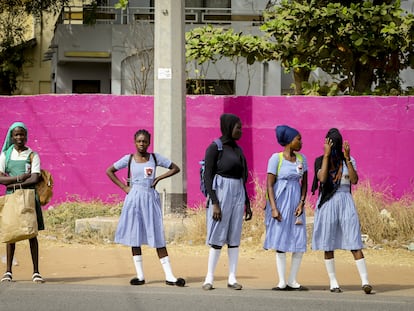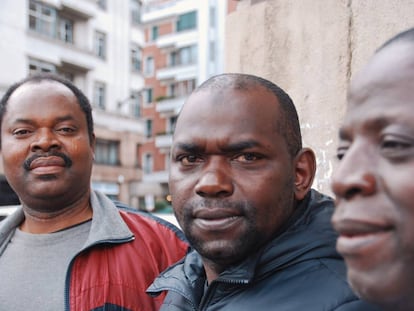The Guinean nurse who stopped performing genital mutilation on girls: ‘In an environment where everyone does one thing, it is very difficult not to do the same’
Djénabou Bélla Diallo, whose clitoris was cut as a child, is now a midwife and renounces the practice. But the custom is still very common in Guinea-Conakry, which has the world’s second highest population of mutilated females

Djénabou Bélla Diallo learned to mutilate girls’ genitals during her university nursing internship at a private clinic in the town of Labé, in west-central Guinea-Conakry. “There is a lot of social pressure. All past generations did it, absolutely all women were mutilated. In an environment where everyone does one thing, it’s very difficult not to do the same thing,” she explains.
Cut as a child herself, Diallo, 35, talks about her work practicing female genital mutilation (FGM) in a rather introverted manner, although she answers all questions. “At the clinic, we stopped mutilating little girls when we understood the physical and psychological damage it causes, and we began to provide training to stop this gender-based violence,” she recalls. Two years ago, she stopped cutting to work as a midwife in a public health center in the district of Pelel, near Labé, the commercial epicenter and capital of one of the eight regions into which Guinea is divided. Since 2021, a military junta has governed this country of 14 million inhabitants; according to the United Nations Population Fund, over 41% of the population is under 14 years of age.
Female genital mutilation or the cutting of a girl’s clitoris is practiced mostly in countries in Africa and the Middle East, despite being prohibited in many of these places. According to UNICEF data, today at least 200 million girls and women in 31 countries have been subjected to genital mutilation. UNICEF says that in general the practice has been declining over the past three decades. But that is not the case in Guinea-Conakry, which has the world’s second-largest population of girls and women who’ve suffered this form of gender violence, after only Somalia. According to the feminist organization Equality Now, 95% of females undergo genital mutilation in Guinea-Conakry.
“In our case [at the clinic], we only cut a piece of the clitoris,” Diallo recalls. “But there are other types of FGM. The most widespread type in Guinea, especially in rural areas, is type three, in which the clitoris, the greater nerves and the upper labia are cut. In private clinics, the procedure is performed with sanitary instruments. In other cases, it is done with scissors, cutters or knives; that is very common in rural areas.” Aissatou Diallo, a Guinean feminist activist based in Barcelona, Spain, adds that this practice is not directly related to religion. “Muslim, Catholic and animist girls are mutilated,” she says.
Each month, Nurse Diallo mutilated two girls between the ages of five and six for approximately 50,000 Guinean francs (about $6.00). In Guinea, the percentage of families who mutilate their daughters at private clinics is very low, as not everyone can afford it, she notes. “There are what are called community mutilators, who go to rural villages, and in exchange for very little money, they offer to perform FGM. In these cases, they don’t mutilate the girls indoors, but take them and mutilate them in the middle of the forest, for example.”
FGM has many different consequences: psychological trauma, serious complications in childbirth and deprivation of sexual pleasure. “It is a macho practice, used to make women more vulnerable from an early age. It is a tool of domination, to weaken us,” emphasizes Aissatou Diallo, nurse Djénabou Diallo’s sister-in-law and the president of AHCAMA, an association working to combat gender-based violence.
Djénabou Diallo says that increasingly more women, especially those of her generation, are refusing to perform FGM on their daughters. She acknowledges that a popular strategy is pretending and claiming that the girls have complied with the rite when it’s not true. “Even [the girls] think they are [mutilated], and when they grow up they find out they are not,” Diallo notes. Asked about her own daughter, Diallo is quick to respond, “We’re not going to mutilate her.”
The practice of FGM is not the only problem Guinean women face. According to World Bank data, barely 31% of the country’s women were literate in 2021. Access to healthcare and basic resources like drinking water is very scarce or non-existent, says Boubacar Sylla, of the Guinean NGO Club des Amis du Monde (CAM). The situation is particularly harsh in rural areas, where approximately 62% of the Guinean population currently lives.
In addition to FGM, there are other problems, such as the forced and early marriage of girls. According to a study by the Autonomous University of Barcelona’s Wassu-UAB Foundation, in 2021, 47% of women in Guinea were married before the age of 18. The same report concluded that a community that legitimizes FGM is more likely to lead its sons and daughters into forced marriages. The study also pointed out that in societies where gender inequalities limit women’s access to economic opportunities, forced marriage is often seen as a good survival strategy to attain some financial security.
Sign up for our weekly newsletter to get more English-language news coverage from EL PAÍS USA Edition
Tu suscripción se está usando en otro dispositivo
¿Quieres añadir otro usuario a tu suscripción?
Si continúas leyendo en este dispositivo, no se podrá leer en el otro.
FlechaTu suscripción se está usando en otro dispositivo y solo puedes acceder a EL PAÍS desde un dispositivo a la vez.
Si quieres compartir tu cuenta, cambia tu suscripción a la modalidad Premium, así podrás añadir otro usuario. Cada uno accederá con su propia cuenta de email, lo que os permitirá personalizar vuestra experiencia en EL PAÍS.
¿Tienes una suscripción de empresa? Accede aquí para contratar más cuentas.
En el caso de no saber quién está usando tu cuenta, te recomendamos cambiar tu contraseña aquí.
Si decides continuar compartiendo tu cuenta, este mensaje se mostrará en tu dispositivo y en el de la otra persona que está usando tu cuenta de forma indefinida, afectando a tu experiencia de lectura. Puedes consultar aquí los términos y condiciones de la suscripción digital.
More information
Archived In
Últimas noticias
Most viewed
- Sinaloa Cartel war is taking its toll on Los Chapitos
- Oona Chaplin: ‘I told James Cameron that I was living in a treehouse and starting a permaculture project with a friend’
- Reinhard Genzel, Nobel laureate in physics: ‘One-minute videos will never give you the truth’
- Why the price of coffee has skyrocketed: from Brazilian plantations to specialty coffee houses
- Silver prices are going crazy: This is what’s fueling the rally










































